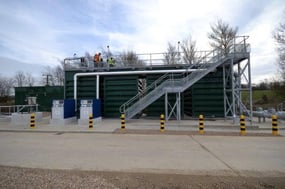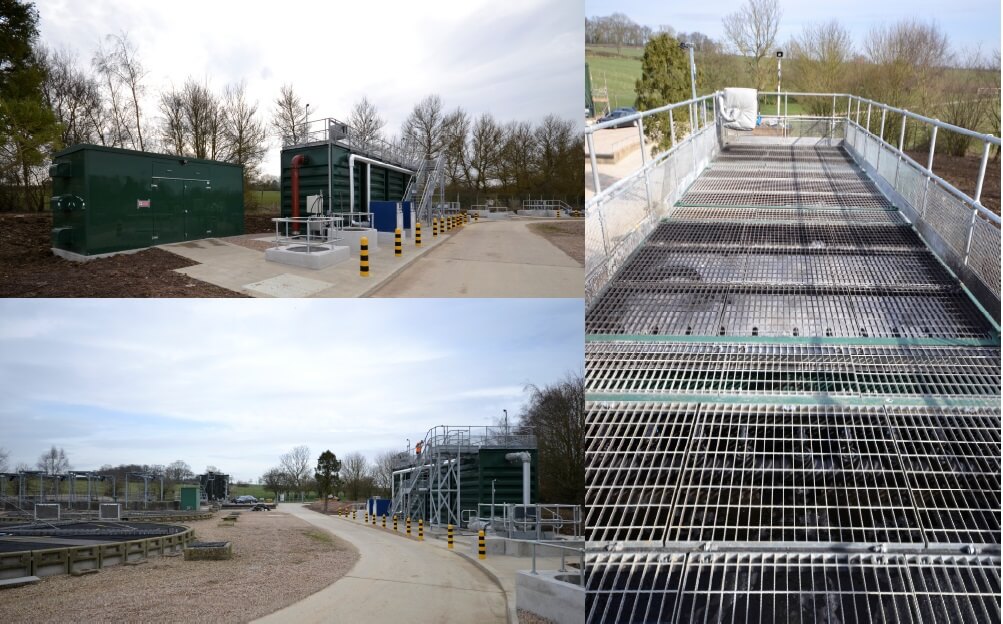We’re on LinkedIn!
Connect with WCS Environmental Engineering Safe Efficient Compliance

Tighter European controls about the release of ammonia into the environment made it necessary to upgrade the treatment plant which serves the English village of Great Glen in Leicestershire.
Ammonia is potentially hazardous to the environment due to its toxic impacts on fish and macro-invertebrates. Sewage effluent from treatment works is a major source of ammonia in rivers, along with diffuse run-off from agriculture.
When the existing ammonia removal system was put in place, regulations stipulated there should not be more than 10mg/l of ammonia in the treated effluent. The new standards imposed by the Environment Agency, in accordance with the European Water Framework Directive, lay down a minimum level of 3mg/l as a 95th percentile standard.
Great Glen is in a hard-to-reach location in the middle of rich farming land, which made it important to find an easy-to-assemble replacement for the existing system for removing ammonia.
Severn Trent Water chose to install a single-stream, nitrifying submerged aerated filter – N-SAF – tertiary treatment plant for ammonia processing.
There were a number of reasons why assembling a pre-manufactured system made sense for contractor MWH, the capital investment delivery partner of Severn Trent.
Restricted access and limited manoeuvrability made it impractical to use a fixed crane to install a single unit. Therefore the replacement plant was manufactured in four modular units, which were lifted into place by a truck-mounted Hiab and connected to form a single plant.
MWH required a whole-life estimate of costs – which meant the system had to be manufactured to a high specification, economical to install and easy to maintain. Because the plants are manufactured offsite and installed as complete individual units, the four component tanks could be delivered and in position within one-and-a-half days – keeping down onsite labour costs and disruption from inclement weather.
The entire system was fully fitted and ready for testing within eight working days. The N-SAF is self-scouring, with no need to desludge units. It has no internal moving parts, which makes it easy to maintain.
The financial constraints and the need to manage operational as well as capital costs made it important to look at energy use during the life of the equipment. The N-SAF is fitted with variable speed drive (VSD) on the blowers to enhance the plant’s energy efficiency. The VSD is linked to dissolved oxygen and ammonia monitors, enabling the client to continually optimise air demand automatically, reducing energy wastage.
Andrew Haywood, Utility Sales Manager states “We were approached by MWH to tender for the provision of a SAF sewage treatment plant designed for tertiary/nitrifying duty. Pre contract several sites for other clients with similar bespoke solutions were visited by both Severn Trent Water and MWH. We were successful in their tender based on both price and the ability to deliver the plant to Severn Trent Waters demanding specification.

With nutrient neutrality requirements being enforced at off-mains properties in areas of England, homeowners need to ...
Why managing variable loads matters If you have an off mains wastewater treatment system operating at a hospitality, ...
Trade effluents are liquid waste streams discharged into public sewers from businesses and industrial processes. Their ...
Connect with WCS Environmental Engineering Safe Efficient Compliance
WCS Group is a trading name for WCS Environmental Ltd, registered in England and Wales (Number 02184649) at 20 Grosvenor Place, London, SW1X 7HN. Head Office – 17 Wheatstone Court, Waterwells Business Park, Gloucester, GL2 2AQ. WCS Group is a Marlowe Critical Services Company owned by Marlowe plc. 2025© WCS Environmental Ltd.